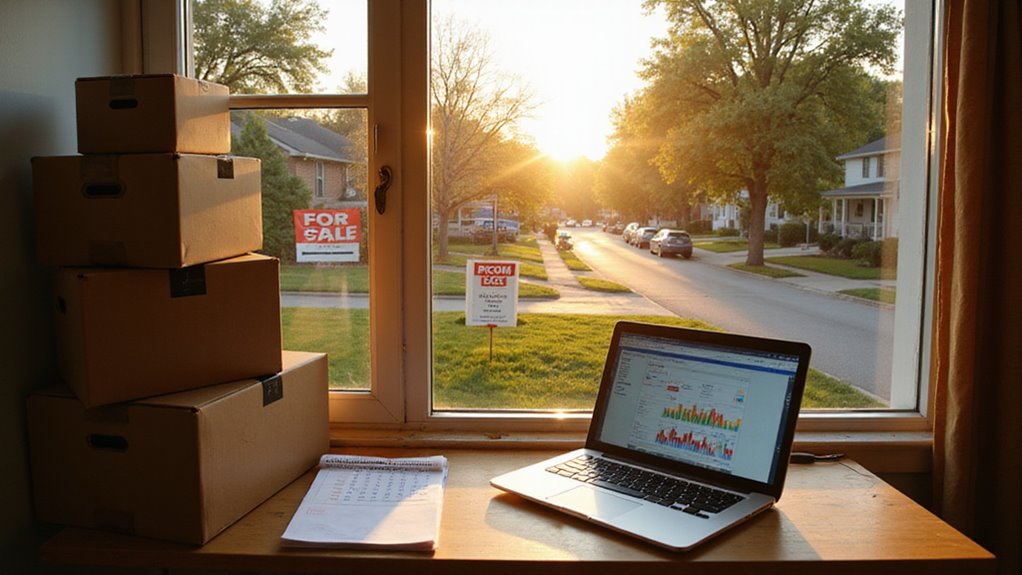Selling your house for relocation can be stressful. Market conditions often determine how quickly you sell and for what price. You may wonder how these changing trends impact your move.
Unpredictable markets can trap your equity or force quick decisions. Buyers may hesitate, or offers may fall short of your needs. You could face delays and added costs if you misread the market.
Market conditions directly affect your sale price, timeline, and negotiation leverage when relocating. Understanding these forces lets you plan, price, and negotiate with confidence. The right strategy can help you move on time and on budget.
This blog will guide you through the impact of market conditions and help you navigate your relocation sale with ease.
Key Takeaways
- Local market type (buyer’s or seller’s market) determines pricing strategies and how quickly a home will sell during relocation.
- Rising interest rates can reduce buyer demand and lower sale prices, potentially slowing your relocation timeline.
- Strong regional job markets boost buyer demand, leading to faster home sales and more favorable relocation outcomes.
- Seasonal trends impact selling speed and price; spring and summer typically offer the best conditions for relocating sellers.
- National housing policies, like tax incentives or mortgage changes, can affect buyer activity and the ease of selling before relocating.
Understanding Buyer’s and Seller’s Markets

Market dynamics affect how easily you can sell your house. If it is a seller’s market, you have more control over price. In a buyer’s market, you may need to adjust your expectations. The ease of selling your home depends on market conditions—seller’s markets favor you, while buyer’s markets may require flexibility.
A seller’s market happens when more people want homes than there are homes available. You can often ask for a higher price in this situation. Buyers may rush to make offers, sometimes leading to bidding wars. In these cases, local real estate expertise can help you navigate offers and choose the best deal.
A buyer’s market occurs when there are more homes for sale than buyers. Setting a competitive price is important in this case. You may also need to improve your home’s appearance to attract interest.
If you know the market type, you can choose the best selling strategy. This helps you sell faster and for the best possible price. Adjust your approach based on demand and supply in your area.
In any market, working with cash home buyers can help you sell your house quickly and avoid repairs, commissions, or lengthy traditional processes.
The Role of Interest Rates in Home Sales
You can’t ignore how interest rates shape what buyers can afford and, in turn, influence your home’s listing price. When rates rise, buyers’ purchasing power shrinks, often forcing sellers to adjust expectations. Monitoring these shifts helps you set a price that aligns with current market realities.
If you’re considering selling your property as-is, it’s important to understand that offers 10-30% below market value are typical since buyers factor in repair costs and risk. Additionally, understanding how capital gains tax may apply when selling your home can help you plan your next steps, especially if you’re considering a move or buying another property.
Buyer Affordability Shifts
Shifts in buyer affordability happen when interest rates change. Higher rates mean buyers can afford less. Lower rates let more buyers enter the market.
If you are selling your house, watch interest rate trends. Rising rates can reduce the number of buyers who qualify. Falling rates can increase demand for your home.
You should understand how these changes affect buyers. If you know the trends, you can better plan your sale. This helps you attract more potential buyers when the time is right.
Impact on Listing Prices
Interest rates have a clear effect on listing prices. When rates change, buyers’ budgets shift, and sellers must adjust their prices. Sellers should watch rate trends to price homes correctly.
Rising rates usually lower buyers’ purchasing power. Sellers may need to lower their prices if buyers cannot afford as much. If rates drop, sellers can sometimes set higher prices.
Pricing should reflect current market conditions and buyer behavior. Sellers who adjust prices in line with interest rates attract more serious buyers. Psychological price points matter more when people have less to spend.
If sellers stay updated on rate forecasts, they can make better pricing decisions. Days on market often increase when rates are high. Sellers should be flexible and ready to change their strategy if needed.
Seasonal Fluctuations in Real Estate Demand

Seasonal fluctuations affect real estate demand every year. Buyer activity and available homes change depending on the time of year. Knowing these patterns helps you make better decisions when selling.
Spring and early summer are the busiest times for real estate. Many families want to move before the new school year starts. If you sell during these months, you may get more interest and better offers. Sellers who want to avoid repairs and showings may also find it easier to sell during these peak seasons.
Spring and early summer bring the most buyer activity, often leading to increased interest and stronger offers for your home.
Late fall and winter usually have fewer buyers. If you sell during these times, your home might stay on the market longer. You could also receive lower offers.
If you can choose when to sell, aim for the peak season. This increases your chances of finding motivated buyers. A well-timed sale can make your move easier and more successful.
If your property is co-owned with others, keep in mind that all owners listed on the deed must agree to the sale before listing, which can affect your timing and strategy for selling.
Local Economic Trends and Their Effect on Home Values
Local economic trends have a direct impact on your home’s value. Changes in jobs, schools, and nearby amenities affect demand. If you want to sell or buy, always check your local area’s situation.
Job growth in your region can lead to higher property values. Good schools and parks make neighborhoods more desirable. If businesses close or jobs are lost, home prices may fall. When considering a move, it’s important to be aware of capital gains tax if your home value has increased.
Construction of new homes can mean a growing area, but too many new homes might lower prices. New roads or public transport can raise values by improving access. If you notice many new shops or restaurants, your area may be gaining value.
When you understand these local trends, you can price your home wisely. This knowledge also helps you decide when to sell or buy. Always consider local factors before making real estate decisions. If you’re looking for a fast and simple way to sell regardless of market trends, working with cash home buyers can provide a reliable solution.
Inventory Levels and Competition Among Sellers

You’ll notice that when inventory is low, your home stands out and may attract stronger offers with less effort. However, if competition among sellers rises, you’ll need to work harder to differentiate your property and capture buyers’ attention.
Understanding where your market sits on this spectrum lets you tailor your strategy for maximum impact. If you’re looking to sell quickly, a no-obligation cash offer can help you avoid fees and streamline the process, even in a crowded market. If you want to skip realtor fees and closing costs, working with a local buyer who offers cash can save you thousands compared to traditional selling.
Low Inventory Advantages
Low housing inventory gives sellers a strong advantage. Fewer homes for sale mean buyers have limited choices. This usually leads to higher demand for each property.
Sellers can often set higher prices if they want to. Multiple offers may come in, which can drive up the final price. Homes also tend to sell faster in these conditions.
Unique and luxury homes stand out more when there are fewer listings. Rural properties may get more attention from city buyers looking to relocate. If you are selling, you may spend less time and money waiting for a buyer.
High Competition Challenges
As competition increases, sellers must work harder to attract buyers. More homes for sale mean buyers have many choices. You need a clear plan to stand out if you want to sell quickly.
If your home has unique features, highlight them in your listing. Eco-friendly upgrades or smart technology can help your property get noticed. Professional photos and staging can also make a big difference.
Pricing is very important in a crowded market. If you set the price too high, buyers may choose other homes. Regularly check similar listings and adjust your strategy if needed.
If you want to succeed, focus on what makes your home special. You should be ready to change your approach if the market shifts. Good preparation and flexibility will help your home sell.
How Regional Job Markets Influence Buyer Demand
Regional job markets directly affect how many people want to buy homes. Strong job growth in an area usually increases buyer demand. Sellers who want a fast & effortless process can benefit from understanding local employment trends. Fewer jobs can slow down the housing market.
Areas with new job opportunities often attract people looking to move closer to work. High employment rates can mean homes sell faster. If job markets weaken, buyers may wait before purchasing.
If new companies move into a region, home prices may rise. Diverse job options help keep housing demand steady, even if some industries struggle. Sellers should watch these trends to plan the best time to list their home.
In certain markets, cash offers provided within 24 hours can help sellers take advantage of strong buyer demand and relocate quickly.
The Impact of National Housing Policies

You can’t ignore how national housing policies shape the real estate landscape, especially regarding mortgage rate fluctuations and tax incentives. These factors directly impact buyer affordability and seller strategies, shifting demand almost overnight. By understanding how policy changes ripple through the market, you’ll make more informed decisions about when and how to sell your property.
Sellers should also be aware that lenders hesitate to approve loans for properties with foundation damage, as these policies can further limit the pool of qualified buyers and affect the speed of your sale. Additionally, working with local North County, MO buyers can help sellers navigate market shifts caused by changing policies and streamline the process.
Mortgage Rate Fluctuations
Mortgage rates change when national housing policies shift. These changes quickly affect the real estate market for both buyers and sellers. Home sellers should pay close attention to these trends.
Higher rates often reduce buyer affordability and slow down sales of expensive homes. Luxury properties may sit longer on the market if rates rise. Rural homes may become more attractive if rates drop, making remote areas easier to afford.
Mortgage rate changes can also cause buyers to rush or hesitate. If rates are expected to rise, buyers may act quickly. Sellers should watch for these shifts to time their listings well.
Refinancing trends can affect buyers who want to upgrade. If rates are low, move-up buyers may enter the market. Sellers should consider this when pricing their homes.
Tax Incentive Effects
Tax incentives in housing policies can directly affect how quickly your house sells. These incentives can include tax breaks for buyers and sellers. If you know about these benefits, you can plan your sale better.
First-time buyer tax breaks and capital gains exclusions may make your home more appealing. These policies can increase buyer demand and help you set a better price. You might also negotiate more favorable terms.
Employer-assisted relocation benefits can work with tax incentives to attract buyers moving for jobs. If these benefits are tax-advantaged, more buyers may enter the market. Staying updated on housing policies helps you sell faster and get a better return.
Pricing Strategies in Different Market Conditions
Pricing strategies change based on market conditions. Sellers need to set prices that match what buyers are willing to pay. This helps attract interest and avoid long waits.
Recent sales in the area show what buyers are paying. Sellers should use this data to choose a realistic price range. If prices are too high, homes may not sell.
Round numbers or small discounts can influence how buyers view the price. These tactics make listings seem more attractive. If the market is slow, a competitive price is even more important.
Current inventory levels matter when setting a price. High supply means sellers may need to lower prices. If supply is low, higher prices might be possible.
Emotional factors like good staging and curb appeal can add value. These features often help homes sell faster. However, all decisions should use market data as a guide.
Seasonal trends can affect demand and price. Sellers should adjust prices if the season changes buyer interest. Still, data from similar sales should guide final pricing choices.
In any market, sellers can benefit from a fast, effortless process that avoids unnecessary costs and offers flexible closing dates.
Timing Your Sale for Maximum Profit

To maximize your profit, you need to strategically time your sale by analyzing seasonal market trends, monitoring shifts in interest rates, and evaluating local inventory levels. These factors directly influence buyer demand and price competition in your area. By staying alert to these market signals, you’ll position your property for the strongest possible return.
Analyzing Seasonal Market Trends
Seasonal trends have a strong impact on real estate prices and buyer interest. If you analyze these patterns, you can choose the best time to sell. Good timing can help you earn more and avoid extra stress.
Spring brings more buyers and higher prices. Summer stays busy, but some buyers pause for vacations. Fall has fewer buyers, but they are often eager to buy.
Winter usually has the lowest activity, but buyers are more serious. Local weather and school schedules can also change these trends. If you track these factors, you can make smarter selling decisions.
Monitoring Interest Rate Changes
Interest rates strongly affect the housing market. If you want to sell your house, you should watch interest rate changes. These rates can influence how many buyers are interested and what price you get.
Lower interest rates often increase buyer demand. This can lead to higher offers on your home. If rates rise, fewer buyers may qualify, and your sale price could drop.
You need to check if rates are going up, down, or staying the same. If possible, sell your house when rates are low or stable. You can follow economic news to help you decide the best time to sell.
Evaluating Local Inventory Levels
Understanding local housing inventory helps you decide the best time to sell your home. The number of homes for sale affects your potential profit. Low inventory means less competition and often higher prices.
If inventory is high, you may need to price your home lower to attract buyers. You should check how many homes are listed each month. Compare current numbers to past trends to spot changes.
Look at how long similar homes stay on the market. Pending sales can show if buyers are active. Use this local data to help set your price.
This approach helps you make smart decisions about selling. Proper timing and pricing can boost your profit. If you track inventory, you can adjust your strategy as needed.
Negotiation Leverage in Fast vs. Slow Markets
Negotiation leverage changes based on how fast homes are selling. Fast markets give sellers more power, while slow markets favor buyers. Understanding this helps you make better decisions.
In a fast market, many buyers compete for homes. Sellers can keep prices high and ask for quick closings. Luxury homes may attract foreign buyers who want exclusivity.
If the market is slow, buyers have more control. Sellers may need to lower prices or offer extra incentives. Luxury properties may be harder to sell if fewer foreign buyers are interested.
Knowing these shifts helps you set fair expectations. You can adjust your offer strategy to get the best results. This approach works no matter how the market is moving.
Marketing Approaches That Work in Any Market
Certain marketing strategies work well in any market. These approaches help sell homes by attracting the right buyers and increasing property visibility. If you use proven methods, you can adjust to market changes easily.
Unique features and amenities should be highlighted in every listing. Professional staging and clear, high-quality photos create strong first impressions. Compelling descriptions focused on benefits help your property stand out.
If you want to reach more buyers, network with agents who know your market. Strategic pricing based on recent sales data is essential. If you set the right price, buyers are more likely to take action.
The Influence of Technology on Selling Speed
Technology helps homes sell faster. Digital tools let sellers showcase properties quickly and reach more buyers. If you need to move soon, using technology can shorten the selling process.
Virtual tours allow buyers to view your home online from any location. High-quality photos and 3D walkthroughs can highlight your home’s best features. These tools attract buyers who are ready to act.
Social media spreads your listing to a wide audience. You can answer questions and schedule showings directly with buyers. If you use these tools, you increase your chances for a fast sale.
Navigating Home Appraisals During Market Shifts
Home appraisals can be unpredictable when the market changes. Price drops or sudden competition can lower your home’s appraised value. If you want a smooth sale, you must understand how these changes affect your appraisal.
Appraisers look at recent nearby sales, but fast changes may make old data less useful. High inventory in your area can push home prices down. You may need to adjust your expectations if the market is shifting quickly.
If the market changes fast, you should prepare early for your appraisal. Appraisers may be very busy, so deadlines can be tight. Your agent’s experience can help you handle any surprises or negotiations.
If you stay informed, you can avoid delays or lost deals. Keep in touch with your agent and watch the local market. This way, you can protect your sale even in uncertain times.
Preparing Your Home to Stand Out in the Current Market
To make your home stand out, focus on what buyers notice first. A neat yard, trimmed plants, and a clean entryway create a good first impression. If buyers see a well-kept exterior, they are more likely to visit.
Inside, staging makes a difference. Arrange furniture simply and use neutral colors so buyers can imagine living there. If your rooms are neat and clutter-free, the space will feel larger.
Fix small problems and paint where needed. These changes can help your home seem move-in ready. If you invest in basic updates, your home could sell faster and for more money.
Conclusion
If you want to sell your house for relocation, you should pay close attention to current market conditions. If the market is strong, you may sell more quickly and at a better price. If the market is slow, you might need to adjust your expectations or strategy.
If you need to move quickly, companies that buy houses for cash can offer a faster solution. If you work with a cash buyer, you can often skip repairs and avoid long waits. This can make your relocation process much smoother.
If you are ready to sell, we at Freedom Path Investors can help you with a fair cash offer. If you contact us today, we will guide you through a simple, stress-free sale. Let us make your move easier and faster.








